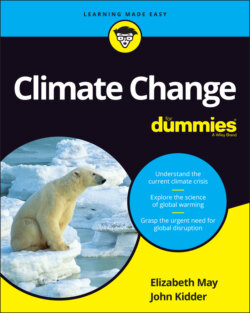Читать книгу Climate Change For Dummies - Elizabeth May - Страница 75
Going, going, gone … The tipping point
ОглавлениеThe tipping point is the point at which something has gone too far — or past the point of no return. Think of slowly going up the first climb on a roller coaster. After you go over the top, no one can stop the ride.
Scientists believe that climate change has a tipping point, when the damage becomes too great to be reversed. After this point, not only can nothing reverse the impact on the planet, but little could stop that impact from increasing, either — it just keeps getting worse.
Scientists figured out, for example, how hot the climate would need to become to melt the entire world’s ice sheets — this melt would cause sea levels to rise, which would flood coastal cities around the world. At the same time, the scientists figured out the amount of GHGs needed to reach these temperatures.
By looking at these different possibilities, scientists can tell which effects of climate change humans can deal with and which ones are beyond humanity’s ability to adapt to or control.
In Global Warming For Dummies, we said that that IPCC had defined an average global temperature rise of about 3.6 degrees F (2 degrees C) above 1850 levels as the official climate change warning zone. But scientists know now that that temperature increase is above the point of no return, or the tipping point. In 2018, in the IPCC’s Special Report on 1.5 Degrees, it found that even holding to 1.5 degrees is no guarantee of a safe climate. If the temperature goes to 5.4 degrees F (3 degrees C), then 7.2 degrees F (4 degrees C) becomes inevitable. At 7.2 degrees F (4 degrees C), then 9 degrees F (5 degrees C) becomes inevitable. And so on. The increases soon outstrip any human ability to slow or control those increases. The increased warming becomes inevitable because of positive feedback loops (see Chapter 7 for the lowdown on feedback loops). Thawing permafrost (the frozen ground in the Arctic) releases methane, speeding more warming. Melting icecaps reveal more open water, which is darker than snow and absorbs rather than reflects the heat of the sun, speeding warmer ocean temperatures and more ice melt. Dryer conditions lead to more forest fires, releasing more carbon and causing more warming. This domino effect can lead to an unlivable world.
No one knows exactly where that tipping point for global warming is. Scientists know only that humanity has a chance to avoid it by holding to 1.5 degrees C. The IPCC says that the average global temperature will rise by 3.6 degrees F (2 degrees C) when total carbon dioxide levels reach 425 to 450 ppm. The trouble is, it’s moving upward at 2 ppm per year and is currently at about 412 ppm of carbon dioxide as we write this.
Uncertainty always exists when it comes to making predictions. The IPCC has found that “The scale of recent changes across the climate system as a whole and the present state of many aspects of the climate system are unprecedented over many centuries to many thousands of years.” The principles in the original 1992 treaty, the UNFCCC, called for action even if uncertainty remained: It’s better to be safe than sorry. The United Nations calls this philosophy the precautionary principle. Unfortunately, governments didn’t exercise the “precautionary” actions. That’s why the Earth is already in a danger zone.
